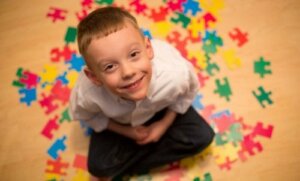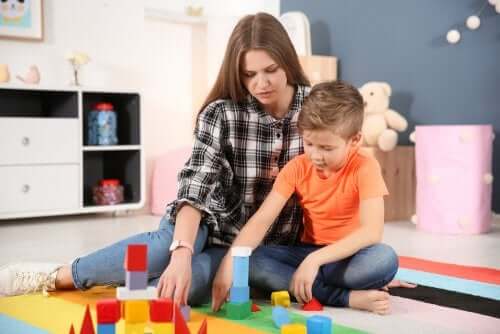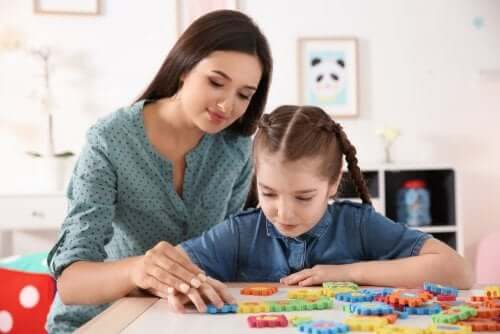Activities for Children with Autism


Written and verified by the psychologist Mara Amor López
Activities for children with autism can be very useful in relieving the challenges of this developmental disorder. Children on the autism spectrum have difficulties when it comes to communicating and interacting with others. It’s very important to work with these individuals in order to optimize their evolution.
As soon as we realize that there’s a problem and offer a solution, the better the prognosis for a child’s future will be. Solutions include carrying out activities, educational games and exercises aimed at helping children to improve their capacities, skills, and communication abilities – especially with their parents.
In this article, we’ll look at some activities for children with autism that will help us reduce the challenges of this disorder, so keep reading.
What should we keep in mind when it comes to activities for children with autism
First of all, it’s important to be well aware of the likes and interests of our children. What’s more, we need to know what types of activities they’re capable of doing according to their age and pace of development. It’s very important for activities to be suitable for our children, according to their individual characteristics. So, you can adapt any of them according to each child’s needs.
When it comes to modifying activities for children with autism, we should keep two things in mind:
- Timing: Establish a duration of time for each activity. What’s more, create a way for the child to see that the activity has a beginning and an end. For example, you can use an hourglass. That way, your little one will know when the activity has begun, and how much time is left before it’s over.
- Choice: We should give children the opportunity to choose from a wide range of possibilities. That being said, they shouldn’t always choose the same activity. Present activities in a visual way, using resources like pictograms, photographs, drawings, etc., and allow children to choose what they want to do.
Activities for children with autism

Activities with music
Music therapy is a very common activity for children with autism. We’ll show you a few examples of what you can do:
- Dance and move to the rhythm of the music.
- Learn simple songs together and sing them. This helps them work on comprehension through song lyrics. Again, you can use visual aids for certain words which will aid in comprehension.
- Make your own music. You can use instruments or any object that makes noise. Making music allows children to experiment with the sounds that different objects make.
Activities with stories
You should adapt this activity and keep in mind whether or not your child enjoys reading. Also, consider the child’s comprehension skills, interests, and choose images that the child will find attractive. You can use:
- Books with different materials: Fabric, embossment, different textures, cardboard, etc. so the child can interact with each material.
- A book full of illustrations: This is a great way to teach children the names of objects. You can also use gastronomy or home decor magazines to point out and name different items.
- Interactive books can be especially attractive for children with autism because of the possibility of producing different effects.
Manipulative activities
Among these activities, we can include those that have to do with the manipulation of and interaction with different objects. For example, crafts involving clay or playdough, rolls of toilet paper, cardboard, yarn, plastic bottles, magazines, etc.
Actually, you can include any object you can think of that you think will spark your child’s interest.
Games for children with autism
Imitation games
You can use clapping games in order for your child to imitate you. For example, create a sequence that your child can copy. You can also imitate the sounds or gestures that different animals make.

Visuospatial play
These types of games include puzzles, buildings and assembly blocks, etc. In some cases, children may need hand-by-hand assistance in order to understand where different pieces go. It’s very important to constantly reinforce them with praise, whether or not they’ve accomplished the activity successfully.
Sensory play
Here we can include games that involve materials that produce pleasant sensations. For example, sand, watercolors, crayons, playdough, different fabrics… In short, anything that you can think of that stimulates the senses and interests your child.
Cause and effect games
This type of game helps us boost a child’s toleration of frustration. For example, we’re talking about games where pushing a button causes a certain action – a light turns on, a sound goes on or off, etc.
Conclusion regarding activities for children with autism
Now that you’ve got a list of activities for children with autism, it’s time to put them into practice. You’re sure to have fun and, at the same time, you’ll help optimize your child’s development and minimize difficulties. So, what are you waiting for?
Activities for children with autism can be very useful in relieving the challenges of this developmental disorder. Children on the autism spectrum have difficulties when it comes to communicating and interacting with others. It’s very important to work with these individuals in order to optimize their evolution.
As soon as we realize that there’s a problem and offer a solution, the better the prognosis for a child’s future will be. Solutions include carrying out activities, educational games and exercises aimed at helping children to improve their capacities, skills, and communication abilities – especially with their parents.
In this article, we’ll look at some activities for children with autism that will help us reduce the challenges of this disorder, so keep reading.
What should we keep in mind when it comes to activities for children with autism
First of all, it’s important to be well aware of the likes and interests of our children. What’s more, we need to know what types of activities they’re capable of doing according to their age and pace of development. It’s very important for activities to be suitable for our children, according to their individual characteristics. So, you can adapt any of them according to each child’s needs.
When it comes to modifying activities for children with autism, we should keep two things in mind:
- Timing: Establish a duration of time for each activity. What’s more, create a way for the child to see that the activity has a beginning and an end. For example, you can use an hourglass. That way, your little one will know when the activity has begun, and how much time is left before it’s over.
- Choice: We should give children the opportunity to choose from a wide range of possibilities. That being said, they shouldn’t always choose the same activity. Present activities in a visual way, using resources like pictograms, photographs, drawings, etc., and allow children to choose what they want to do.
Activities for children with autism

Activities with music
Music therapy is a very common activity for children with autism. We’ll show you a few examples of what you can do:
- Dance and move to the rhythm of the music.
- Learn simple songs together and sing them. This helps them work on comprehension through song lyrics. Again, you can use visual aids for certain words which will aid in comprehension.
- Make your own music. You can use instruments or any object that makes noise. Making music allows children to experiment with the sounds that different objects make.
Activities with stories
You should adapt this activity and keep in mind whether or not your child enjoys reading. Also, consider the child’s comprehension skills, interests, and choose images that the child will find attractive. You can use:
- Books with different materials: Fabric, embossment, different textures, cardboard, etc. so the child can interact with each material.
- A book full of illustrations: This is a great way to teach children the names of objects. You can also use gastronomy or home decor magazines to point out and name different items.
- Interactive books can be especially attractive for children with autism because of the possibility of producing different effects.
Manipulative activities
Among these activities, we can include those that have to do with the manipulation of and interaction with different objects. For example, crafts involving clay or playdough, rolls of toilet paper, cardboard, yarn, plastic bottles, magazines, etc.
Actually, you can include any object you can think of that you think will spark your child’s interest.
Games for children with autism
Imitation games
You can use clapping games in order for your child to imitate you. For example, create a sequence that your child can copy. You can also imitate the sounds or gestures that different animals make.

Visuospatial play
These types of games include puzzles, buildings and assembly blocks, etc. In some cases, children may need hand-by-hand assistance in order to understand where different pieces go. It’s very important to constantly reinforce them with praise, whether or not they’ve accomplished the activity successfully.
Sensory play
Here we can include games that involve materials that produce pleasant sensations. For example, sand, watercolors, crayons, playdough, different fabrics… In short, anything that you can think of that stimulates the senses and interests your child.
Cause and effect games
This type of game helps us boost a child’s toleration of frustration. For example, we’re talking about games where pushing a button causes a certain action – a light turns on, a sound goes on or off, etc.
Conclusion regarding activities for children with autism
Now that you’ve got a list of activities for children with autism, it’s time to put them into practice. You’re sure to have fun and, at the same time, you’ll help optimize your child’s development and minimize difficulties. So, what are you waiting for?
This text is provided for informational purposes only and does not replace consultation with a professional. If in doubt, consult your specialist.








